Carlsbad Caverns, Part the Second
Before we start on the next part of the tour, I'd like to say a few words about the park's audio devices. Twelve years ago, the audio devices were called "listening sticks," and they picked up signals from transmitters near famous formations and other points of interest. There were signs along the route that told you when to start listening. They were a tad wonky, because if you strayed beyond the range of the signal, your audio would fade out and you'd have to wander back within range to hear the rest of the segment. But as I recall, they had neckstraps.
Today, the audio devices have a keypad with numbers. There are numbered signs along the route, and all you have to do is key in the number and the correct audio segment comes on. You can stop it anytime you wish, or you can repeat it--a nice feature. Although my memory of the audio portion of the erstwhile tour is rather (well, very) hazy, I recall that it was full of good information, but rather staid--and sometimes kind of technical. As I'm a cave nerd, I liked that. Today, though, the audio *hosts* are a man and a woman who seem just a tad too jolly about the cave. True, the audio includes interviews with rangers and cavers and such (the description of the ascent to a room called the Spirit World near the ceiling at the Top of the Cross was fascinating), and that was great, but we became a tad skeptical when the hosts kept exclaiming that this or that feature was their "favorite formation EVER" or words that effect. A bit too effusive. And if you know anything about how such things are recorded, the odds are that these guides never set foot inside the cave. If I had my druthers, the powers that be at Carlsbad would rework the audio to be somewhere in between the serious and the effusive (keeping the interviews, of course). And they should replace the wrist straps on the current audio devices with those handy neckstraps. It's hard to keep a camera steady with a long plastic thingy dangling from one of your arms. Just sayin'.
Sermon over--tour is about to resume. Most of the photos in this post are courtesy of Rachel, to give credit where credit is due. I'll lay claim to the ones that are mine as they appear.
The King's Palace tour takes in four lavishly decorated chambers called, collectively, the scenic rooms. Tours through these rooms are guided because people just can't seem to resist the urge to break off cave formations and take them home as souvenirs--and there is much to tempt the would-be cave vandal in these chambers. It's nice to have the rangers along, though, because they offer a wealth of information on the history of the cave, both geologic and human. The tour branches off from the natural entrance route not far from the Big Room. Near the entrance to the King's Palace you encounter undeniable visual evidence of the great age of the cave:
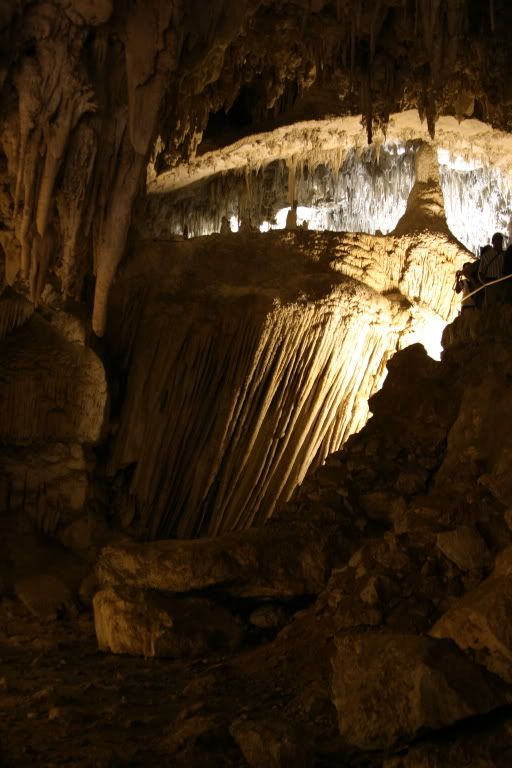
Notice how the huge, flowstone-encrusted boulder has broken free from a seam near the ceiling. The vertical fluting of the flowstone is askew. Now look at the top of this boulder. Not only have myriad stalactites *grown* from the ceiling above the rock--the ceiling the rock once clung to--but there are sizeable stalagtites rising from the top of broken boulder. One of them--the largest--may even be a column. It looks as if it comes very near to reaching the ceiling if it has not yet done so. One of the notable features of the natural entrance route is the trail that skirts Iceberg Rock--a huge portion of the entryway ceiling that broke free and fell a long, long time ago. I think the breakdown in the picture above may have been a result of this fall, as it seems to be near, but below, where the huge piece of ceiling fell. It looks as if Iceberg Rock fell, dislodging this rock below it. If so, think of how long it would have taken for the slow drip of water and deposition of stone to build that big stalagmite. Then think how long it took for the flowstone to cover that boulder in the first place.
The cave is rather dry now (although there was water dripping here and there--and some of it dripped on me...), but the sheer abundance of stalactites in the King's Palace indicates that many millennia ago a tour through the cave would have seemed like a hike through a rainstorm.

Although nowhere near as big as the Big Room, the King's Palace is spacious and chock-a-block with stalactites. Here is a detail of the ceiling in the King's Palace:

It was here that the ranger who led the tour gave his geology talk about the formation of the cavern and the way the common speleothems form. This room is also the location of an almost column--a feature called the Eternal Kiss. It is a stalagmite and a stalactite that are so close to joining that you can barely slip a credit card between them. I remember this clearly from my first and second visits, but no mention of it was made this time--and I didn't think to look for it until our tour was over, alas.
The next room on the tour is the Papoose Room. It's full of soda straws and lovely creamy white speleothems. This is one of my snapshots:
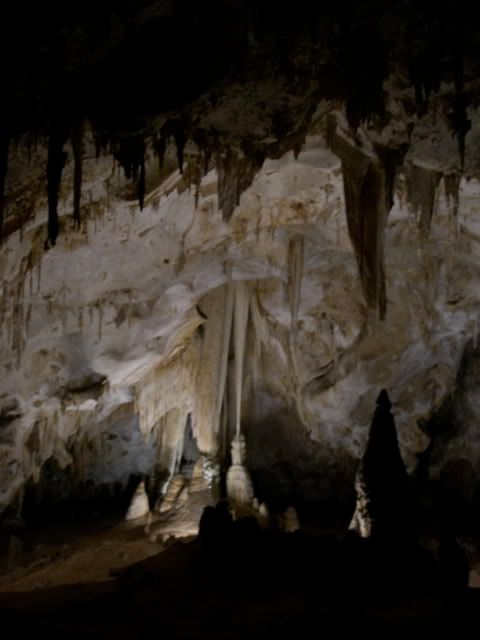
Not a lot of soda straws in this particular picture, but note the creamy white draperies and the elegant column. This photo of Rachel's shows these formations in a wider context:
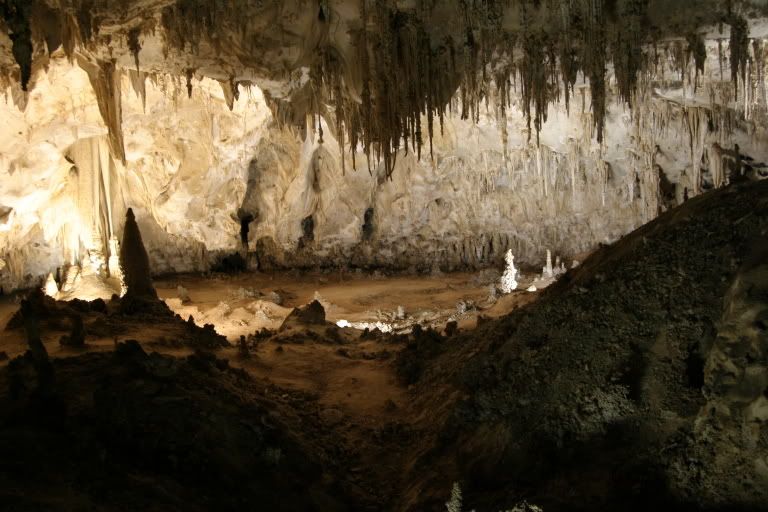
The formations in my photo appear to the left of the chamber.
Here is another lovely white speleothem in the Papoose Room:

You can also get an idea of the profusion of soda straws in this room from this picture, although the next photo really does the Papoose Room proud:
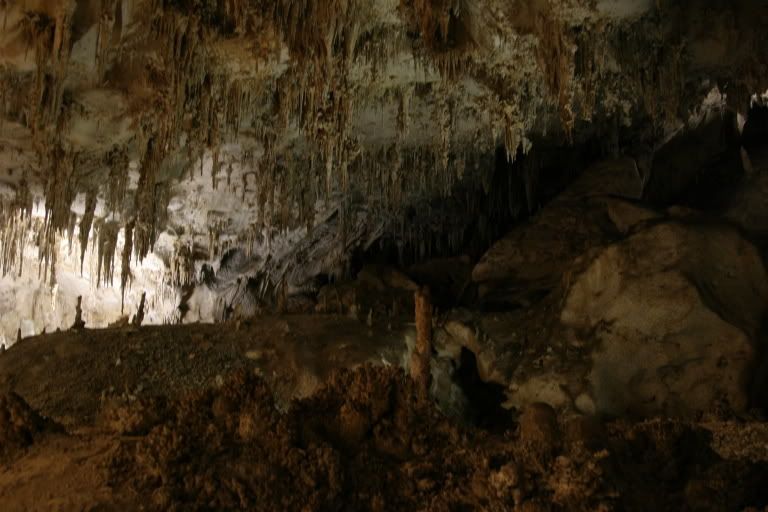
Why is it called the Papoose Room? I have no idea, except maybe because it's the smallest of the scenic rooms, or because it is between the King's Palace and the Queen's Chamber, or both? At any rate, it's one of my favorite rooms. But you could tell that, huh?
The Queen's Chamber is famous for its profusion of speleothems, including some voluminous draperies. This is the spot on the tour where the rangers doused the lights and we sat in utter darkness as the lead ranger recounted the story of Jim White and his exploration of the cave. Instead of just switching the lights back on, the ranger lit a candle lantern he had brought with him, and we were able to see the cave by lantern light--it looked very different from the chamber we saw when we first entered this room--brightly lit by electric lights strategically placed to show the formations to best advantage. Every cave I've ever visited does the "cave darkness" spiel where they turn off the lights and you can't see your hand in front of your face (but, oddly, you sense it in a way you can't when you do the same thing in the light). But this was a very classy, memorable way to present the concept. A very nice touch.
With the lights on, here is what awaits you in the Queen's Chamber:
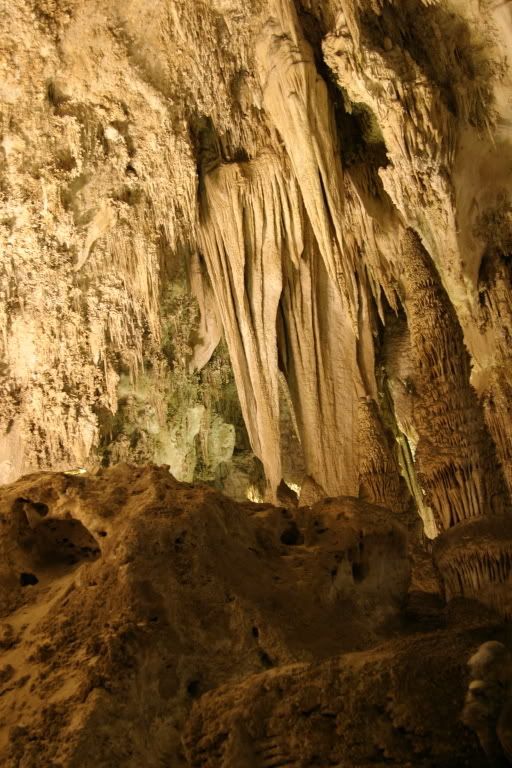
You can see some of the draperies near the center. The helictites are clinging to the wall on the left.
From the Queen's Chamber, the trail winds to the Green Lakes, two green-tinged pools that reflect the formations and passages that loom above them. The expanse between the two scenic rooms winds is quite scenic itself:

Beth, my good buddy and pal, study this photo carefully. This is the picture we should have had the gumption to take when we visited lo, those many years ago. Wink, wink, nudge, nudge. Heh heh. Sod those old ladies. They would have understood. (Everyone else, please don't ask me to explain. Just draw your own conclusions. Thanks!)
Here is one of the Green Lakes--this one is my snapshot:
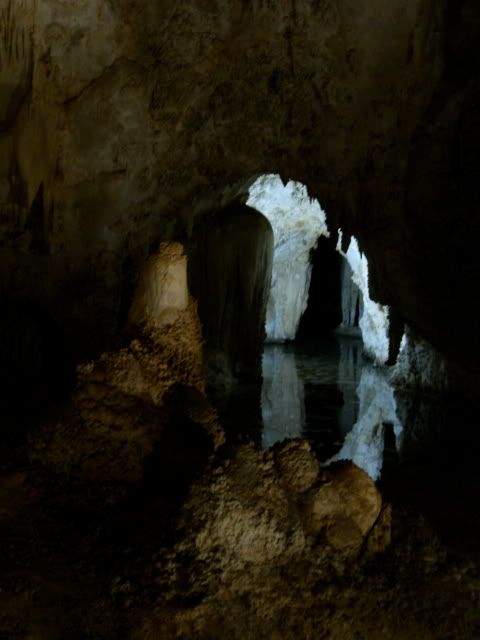
Doesn't this make you wonder what lies beyond that archway?
The chamber where the Green Lakes are situated is also where you will find the Veiled Statue (see Part the First), the final featured speleothem on the King's Palace tour. Although it is a lovely, fluted column and rightly holds sway as one of the "must sees" in the cave, the chamber has other intriguing formations:
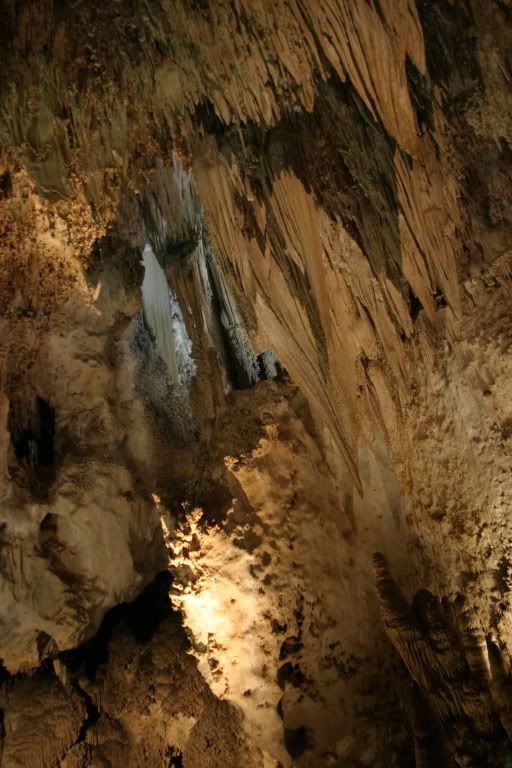
If you look very closely at the photo of this area in the first part of the Carlsbad Caverns travelogue posts, you will notice right where these features are in relation to the Veiled Statue. The draperies upon draperies, the odd assemblage of stalagmites, and the promise of something beyond, behind the curtains of stone. That is the lure of Carlsbad.
Next up: the last of the Carlsbad trip narratives. But it will have to wait until at least tomorrow. The Daily Show is about to come on.
Today, the audio devices have a keypad with numbers. There are numbered signs along the route, and all you have to do is key in the number and the correct audio segment comes on. You can stop it anytime you wish, or you can repeat it--a nice feature. Although my memory of the audio portion of the erstwhile tour is rather (well, very) hazy, I recall that it was full of good information, but rather staid--and sometimes kind of technical. As I'm a cave nerd, I liked that. Today, though, the audio *hosts* are a man and a woman who seem just a tad too jolly about the cave. True, the audio includes interviews with rangers and cavers and such (the description of the ascent to a room called the Spirit World near the ceiling at the Top of the Cross was fascinating), and that was great, but we became a tad skeptical when the hosts kept exclaiming that this or that feature was their "favorite formation EVER" or words that effect. A bit too effusive. And if you know anything about how such things are recorded, the odds are that these guides never set foot inside the cave. If I had my druthers, the powers that be at Carlsbad would rework the audio to be somewhere in between the serious and the effusive (keeping the interviews, of course). And they should replace the wrist straps on the current audio devices with those handy neckstraps. It's hard to keep a camera steady with a long plastic thingy dangling from one of your arms. Just sayin'.
Sermon over--tour is about to resume. Most of the photos in this post are courtesy of Rachel, to give credit where credit is due. I'll lay claim to the ones that are mine as they appear.
The King's Palace tour takes in four lavishly decorated chambers called, collectively, the scenic rooms. Tours through these rooms are guided because people just can't seem to resist the urge to break off cave formations and take them home as souvenirs--and there is much to tempt the would-be cave vandal in these chambers. It's nice to have the rangers along, though, because they offer a wealth of information on the history of the cave, both geologic and human. The tour branches off from the natural entrance route not far from the Big Room. Near the entrance to the King's Palace you encounter undeniable visual evidence of the great age of the cave:

Notice how the huge, flowstone-encrusted boulder has broken free from a seam near the ceiling. The vertical fluting of the flowstone is askew. Now look at the top of this boulder. Not only have myriad stalactites *grown* from the ceiling above the rock--the ceiling the rock once clung to--but there are sizeable stalagtites rising from the top of broken boulder. One of them--the largest--may even be a column. It looks as if it comes very near to reaching the ceiling if it has not yet done so. One of the notable features of the natural entrance route is the trail that skirts Iceberg Rock--a huge portion of the entryway ceiling that broke free and fell a long, long time ago. I think the breakdown in the picture above may have been a result of this fall, as it seems to be near, but below, where the huge piece of ceiling fell. It looks as if Iceberg Rock fell, dislodging this rock below it. If so, think of how long it would have taken for the slow drip of water and deposition of stone to build that big stalagmite. Then think how long it took for the flowstone to cover that boulder in the first place.
The cave is rather dry now (although there was water dripping here and there--and some of it dripped on me...), but the sheer abundance of stalactites in the King's Palace indicates that many millennia ago a tour through the cave would have seemed like a hike through a rainstorm.

Although nowhere near as big as the Big Room, the King's Palace is spacious and chock-a-block with stalactites. Here is a detail of the ceiling in the King's Palace:

It was here that the ranger who led the tour gave his geology talk about the formation of the cavern and the way the common speleothems form. This room is also the location of an almost column--a feature called the Eternal Kiss. It is a stalagmite and a stalactite that are so close to joining that you can barely slip a credit card between them. I remember this clearly from my first and second visits, but no mention of it was made this time--and I didn't think to look for it until our tour was over, alas.
The next room on the tour is the Papoose Room. It's full of soda straws and lovely creamy white speleothems. This is one of my snapshots:

Not a lot of soda straws in this particular picture, but note the creamy white draperies and the elegant column. This photo of Rachel's shows these formations in a wider context:

The formations in my photo appear to the left of the chamber.
Here is another lovely white speleothem in the Papoose Room:

You can also get an idea of the profusion of soda straws in this room from this picture, although the next photo really does the Papoose Room proud:

Why is it called the Papoose Room? I have no idea, except maybe because it's the smallest of the scenic rooms, or because it is between the King's Palace and the Queen's Chamber, or both? At any rate, it's one of my favorite rooms. But you could tell that, huh?
The Queen's Chamber is famous for its profusion of speleothems, including some voluminous draperies. This is the spot on the tour where the rangers doused the lights and we sat in utter darkness as the lead ranger recounted the story of Jim White and his exploration of the cave. Instead of just switching the lights back on, the ranger lit a candle lantern he had brought with him, and we were able to see the cave by lantern light--it looked very different from the chamber we saw when we first entered this room--brightly lit by electric lights strategically placed to show the formations to best advantage. Every cave I've ever visited does the "cave darkness" spiel where they turn off the lights and you can't see your hand in front of your face (but, oddly, you sense it in a way you can't when you do the same thing in the light). But this was a very classy, memorable way to present the concept. A very nice touch.
With the lights on, here is what awaits you in the Queen's Chamber:

You can see some of the draperies near the center. The helictites are clinging to the wall on the left.
From the Queen's Chamber, the trail winds to the Green Lakes, two green-tinged pools that reflect the formations and passages that loom above them. The expanse between the two scenic rooms winds is quite scenic itself:

Beth, my good buddy and pal, study this photo carefully. This is the picture we should have had the gumption to take when we visited lo, those many years ago. Wink, wink, nudge, nudge. Heh heh. Sod those old ladies. They would have understood. (Everyone else, please don't ask me to explain. Just draw your own conclusions. Thanks!)
Here is one of the Green Lakes--this one is my snapshot:

Doesn't this make you wonder what lies beyond that archway?
The chamber where the Green Lakes are situated is also where you will find the Veiled Statue (see Part the First), the final featured speleothem on the King's Palace tour. Although it is a lovely, fluted column and rightly holds sway as one of the "must sees" in the cave, the chamber has other intriguing formations:

If you look very closely at the photo of this area in the first part of the Carlsbad Caverns travelogue posts, you will notice right where these features are in relation to the Veiled Statue. The draperies upon draperies, the odd assemblage of stalagmites, and the promise of something beyond, behind the curtains of stone. That is the lure of Carlsbad.
Next up: the last of the Carlsbad trip narratives. But it will have to wait until at least tomorrow. The Daily Show is about to come on.

1 Comments:
I would love to take another cross-country road trip--you know I'm always up for stuff like that!
The offending formation is actually kind of up high, although I THOUGHT I distinctly recalled that it was down near one of the Green Lakes--but I'm sure that's the one. The one near the "lake" is less detailed (and, um, uncut). People were kind of looking at the *one* and pointing and giggling, but I've grown bolder with advancing age. I was snapping away, trying to get several angles. Heh heh.
Maybe the three of us could have a fellow tour member snap a picture of us pointing at it!
Post a Comment
<< Home